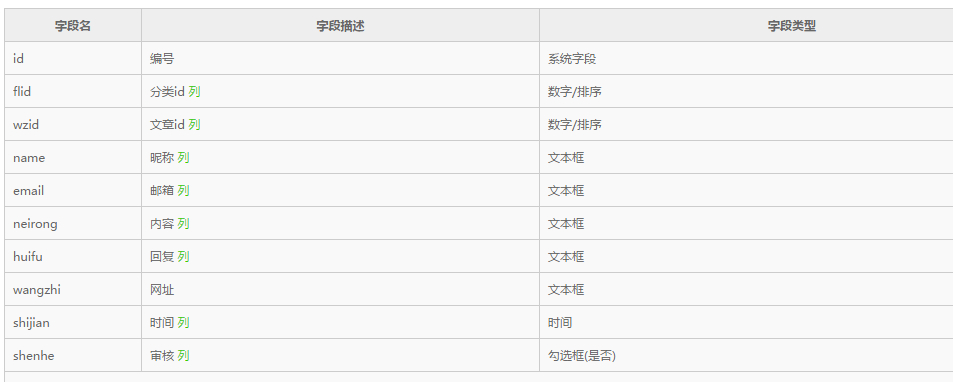一. 创建评论栏目
- 在ucms后台创建文章栏目,名称为评论,修改数据表为不同的名称,如我的为“dazeng_comment”,栏目地址为“/comment.php”,模板文件为“comment.php”,并将“导航栏显示”前的勾去掉;
- 点击字符段管理,添加字符段,这里可以根据你自身情况添加不同的字符段,我的见下图:

其中flid(分类id)和wzid(文章id)必不可少。
二、发表评论模板
<form action="{uri(/comment.php)}" method="post" id="commentform" class="comment-form">
<div style="display:none;">
<input type="text" name="flid" value="{$article[cid]}" /><input type="text" name="wzid" value="{$article[id]}" />{//因为这两个参数不需要用户输入,所以选择隐藏}
</div>
<textarea placeholder="文明和谐评论" name="comment" rows="5"></textarea> <input placeholder="昵称" name="comname" type="text" size="30" /> <input placeholder="邮箱" name="commail" type="text" size="30" /> <input placeholder="网站" name="comurl" type="text" size="30" /> <input name="submit" type="submit" value="发表评论" />
</form>三、发表提交后的操作代码(即模板comment.php)
{if isset($_POST["comname"])}
{$set=array()}{//这一行开始判断以前是否评论过且通过审核,判断的依据是数据库中是否存在评论人的email,该email通过审核的评论数是否为0}
{$set['cid']=6}{//这里的6是你评论栏目的cid}
{$set['where']['email']=$_POST['commail']}
{$set['pagesize']=1}
{$set['where']['shenhe']=1}
{$articles=alist($set)}
{if count($articles['list'])!=0}
{$shenhe=1}
{else}
{$shenhe=0}
{/if}{//直到这儿结束是否评论过且通过审核的判断}
{$newarticle=array()}
{$newarticle['cid']=6}
{$newarticle['name']=$_POST["comname"]}
{$newarticle['email']=$_POST["commail"]}
{$newarticle['wangzhi']=$_POST["comurl"]}
{$newarticle['neirong']=$_POST["comment"]}
{$newarticle['flid']=$_POST["flid"]}
{$newarticle['wzid']=$_POST["wzid"]}
{$newarticle['shenhe']=$shenhe}
{$id=ainsert($newarticle)}
{if $id>0}
{//以上代码没有难度,完全来自官方,需要注意$post['名称']里面的名称必须与发表评论代码中的一致}
{//以下代码是判断跳转的页面地址,就是发表评论的那篇文章的地址,这种方法需要不具备通性,还有一种判断方法,待会儿在侧边栏显示最新评论那儿会讲}
{if $_POST["flid"]==1}
{$fl='Logs'}
{elseif $_POST["flid"]==2}
{$fl='Articles'}
{elseif $_POST["flid"]==3}
{$fl='Works'}
{else}
{/if}
{$url='/'.$fl.'/'.$_POST["wzid"].'.html';}
<meta http-equiv="refresh" content="1; url=<?php echo $url;?>#comments" />
<p style="text-align:center;">
<strong>评论成功{if $shenhe=="1"}并通过审核{else}等待审核{/if}。 </strong>
</p>
{else}
<p style="text-align:center;">
<strong>评论失败,请检查留言内容。<a href="javascript:void(history.back())">返回修改</a></strong>
</p>
{/if}
{else}
{notfound()}
{/if}四、显示评论
<ol class="comment-list">
{$set=array()}
{$set['cid']='6'}{//同样是评论栏目的cid}
{$set['where']['flid']=$article['cid']}
{$set['where']['wzid']=$article['id']}
{$set['where']['shenhe']=1}{//只通过审核通过的评论}
{$articles=alist($set)}
{loop $articles['list'] as $a}
{$grav_url = "https://www.gravatar.com/avatar/".md5(strtolower(trim($a[email])));}{//显示gravatar头像}
<li id="comment-{$a['id']}" class="comment depth-1 parent odd">
<div class="comment-body">
<div class="comment-author vcard">
<img alt="" src="{$grav_url}" class="avatar avatar-50 photo" height="50" width="50" /><cite class="fn"><a href="{$a['wangzhi']}" target="_blank" title="{$a['name']}">{$a['name']}</a></cite><span class="says">说道:</span>
</div>
<div class="comment-meta commentmetadata">
<a>{$a['shijian']|date('Y-m-d H:i:s',this)}</a>
</div>
<p>{$a['neirong']}</p>
{if $a['huifu']}<p style="color:#be0000;display:block;margin-left:2em;">Dazeng回复:{$a['huifu']}</p>{/if}
</div>
</li>
{/loop}
</ol>五、侧边栏显示最新评论
{$set=array()}
{$set['cid']=6}{//同样是评论栏目的cid}
{$set['pagesize']=8}{//显示条数}
{$set['where']['shenhe']=1}{//显示已经审核的}
{$articles=alist($set)}
{loop $articles['list'] as $a}
{//以下就是判断的第二种方法,这种方法更好,具有通用性呵呵}
<a class="list-group-item " href="
{$set=array()}
{$set['cid']=$a['flid']}
{$set['where']['id']=$a['wzid']}
{$set['all']=0}{$fromarticle=a($set)}
{if $fromarticle}{$fromarticle['link']}
{/if}
" title="{$a['name']}:{$a['neirong']}" ><i class="fa fa-comments-o"></i>{$a['name']}:{$a['neirong']|text(20)}...</a>
{/loop}UCMS增加评论差不多就这样,但以上不适合单页栏目的评论,单页栏目的评论可以将以上的所有涉及到文章id的都去掉,单独搞一套就OK了,当然也可以合并起来,增加一点判断就可以了.
非原创转自原文链接